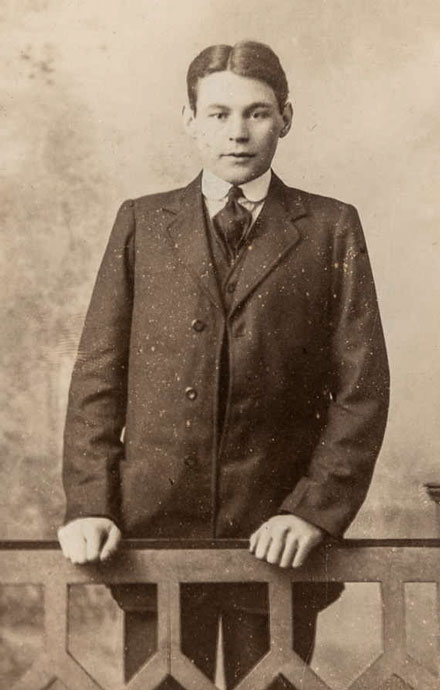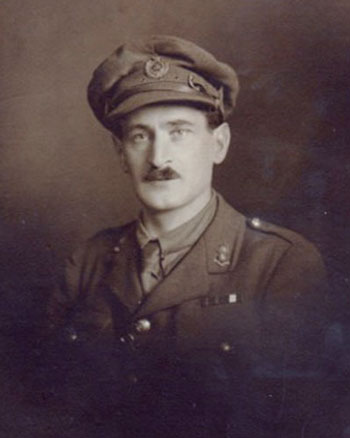Second Lieutenant John Newell

John Newell was born on 16 January 1890 at Union Place, Dungannon, County Tyrone, the sixth of eight children of butcher (later victualler) Joseph Newell and his wife Mary (née Harding). At the time of the 1911 Census he was living in Perry Street, Dungannon, with his parents and three of his five surviving siblings. From 1908 to 1914 he worked in the County Surveyor's Department of the Tyrone County Council, by 1914 reaching the position of Assistant County Surveyor.
Newell enlisted in the 6th (Inniskilling) Dragoons Service Squadron at Dungannon on 31 October 1914 (No. UD/93 – later Corps of Dragoons No.21238). His departure from Dungannon to join the squadron at Enniskillen was mentioned in the Mid-Ulster Mail of 7 November:
Enthusiastic scenes were witnessed at Dungannon railway station on Monday morning, when six local members of the Ulster Volunteer Force left for Enniskillen to join the extra service squadron of the Royal Inniskilling Dragoons. They were Messrs. Jack Newell, Randall McManus, and Sandy Williamson, A Company, Dungannon Battalion U.V.F., and Messrs. W.J. Armstrong, Garnet Irwin, and Alexander Watt, of B Company. A very large crowd of friends and well-wishers had assembled to give them a hearty send-off, and as the train left the station loud cheers were raised and detonators exploded.
Newell was immediately promoted to the rank of lance corporal, and subsequently corporal (12 November 1914), lance sergeant (3 May 1915), and sergeant (16 November 1915). In November 1915 he applied for a commission in the Royal Engineers, but it appears he was unsuccessful.
On 22 May 1915 he married school teacher Charlotte McMenemy in Castlecaulfield Presbyterian Church.
On 6 October 1915 Newell embarked for France with his squadron, which was then serving as divisional cavalry to the 36th (Ulster) Division. In June 1916 the squadron joined with C and F Squadrons of the North Irish Horse to form the 2nd North Irish Horse Regiment, serving as corps cavalry to X Corps.
Newell applied for a commission in the cavalry on 11 January 1917. He returned to the UK for officer training on 21 February, reporting for duty at No.1 Cavalry Cadet Squadron at Netheravon on 23 April. He was, however, found unsuitable for a commission in the cavalry, and on 7 September was transferred to No.11 Officer Cadet Battalion (infantry) at Pirbright. He was commissioned as a 2nd lieutenant on 18 December 1917 and posted to the 51st (Graduated) Battalion, Sherwood Foresters (Notts and Derby Regiment) at Thoresby Camp, Worksop.
Newell arrived in France on 14 June 1918, attached to the 1st Battalion, Notts & Derbys, but on 29 July he was attached to the 39th Battalion, Machine Gun Corps as company transport officer. He transferred to that corps on 12 September. He returned to the UK with the cadre of his battalion on 26 March 1919. Released from army service on 16 April 1919, he relinquished his commission on 26 November 1920.
After the war Newell returned to Dungannon and his work as a county surveyor. He died at his home, 42 Northland Row, Dungannon, on 8 June 1962 and was buried in Drumcoo Cemetery.
Two of Newell's brothers also served during the war. Captain Charles Newell of the Royal Engineers died of wounds in France on 24 March 1918 and is buried in the St Hilaire Cemetery, Frevent. Henry Newell served in the North Irish Horse. The other surviving brother, Robert Lancelot Harding Newell, who worked at the Inland Revenue officer in Dundalk, "had also volunteered for active service, but his department could not spare him". (Tyrone Courier, 9 September 1915).

Captain Charles Newell
Image of John Newell sourced from Ancestry.com Public Member Trees – contributor Peter Dixon. Image of Charles Newell sourced from the Dungannon War Dead site, provided to the site by Wayne Starr.
This page last updated 26 February 2023.
